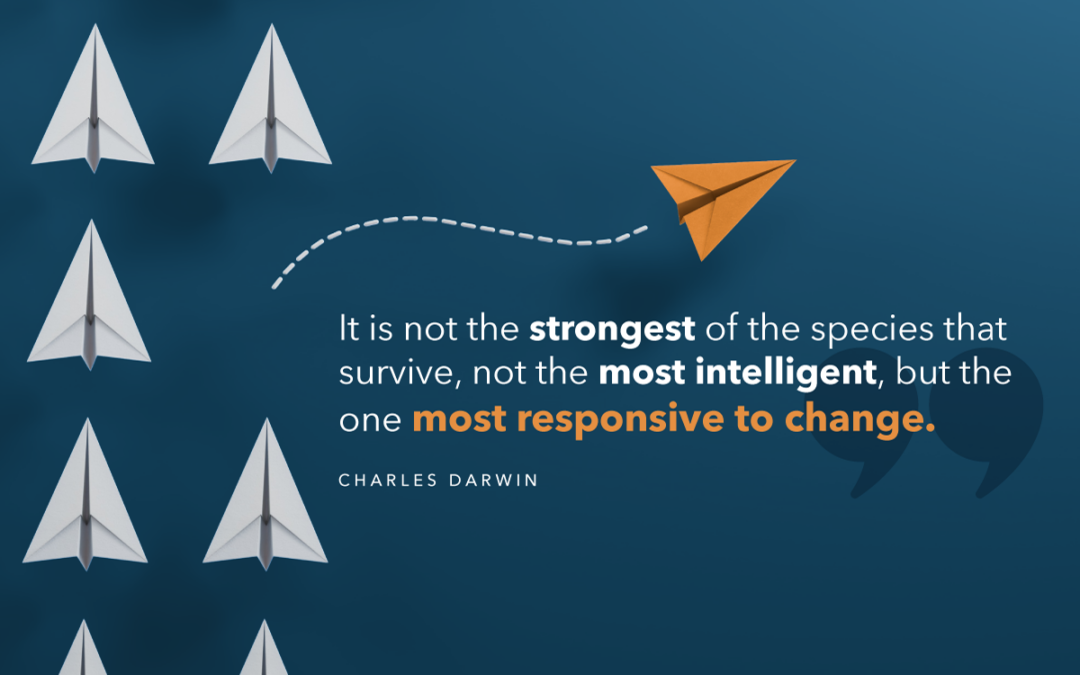Innovation vs. Status Quo
We’ve all heard the phrase “survival of the fittest” applied to our species and the biological world. Should that not also apply to our organizations? It seems that staying relevant to a changing environment is what Charles Darwin was talking about and that it would be paramount to the longevity of any organization.
At Next Stage, we believe in that principle and help our partners take the bold steps required to evolve and align their organizations with the momentous shifts happening in the world. This approach requires a disciplined innovation mindset that relies on courage, thoughtfulness, more care, and time. While this may feel risky, it’s actually the safest thing to do. However, it is the path of most resistance, which is why so few people take it.
The Riskiest Thing To Do Is Play It Safe
Did you know the first digital camera was introduced within the Kodak organization? Yes, one of Kodak’s engineers, Steve Sasson, created a digital camera prototype roughly the size of a toaster. The plot thickens: Larry Matteson, another Kodak employee, authored a report in 1979 predicting a complete shift to digital photography would occur in 2010.
Instead of embracing dual transformation and recognizing that, as one of the most powerful companies in the world, it was best poised to reintroduce a reimagined way of capturing photography, executives led with fear. They held firm that as the leading provider of film, digital photography would be an antithesis to what they thought was their core business.
What if they had reframed their core business from being the largest provider of film to instead being in the business of capturing the most precious moments in people’s lives? What if they had listened and valued the thinking of their team members? Might they have fought the most powerful force in the universe – regression to the mean?
Kodak filed for bankruptcy protection in 2012 and restructured the organization in 2013 as a significantly smaller company. Now that’s a Kodak moment!
Reframing What Counts As Health
As dedicated leaders advocating for all people to have access to quality health and their essential needs, we’re initiating radical change. A one-size-fits-all solution or a plug-and-play implementation plan rarely exists to define the path forward.
We must embrace the innovation imperative because of the momentous shifts happening both within and outside the industry. Moreover, health can no longer operate in a silo and must transcend into other areas impacting the holistic well-being of a person and communities. These momentous shifts are manifested in several ways from the rapidly changing expectations and preferences of the evolving population to the technology revolution.
“People who effect radical change have to exhibit an uncompromising faith in experimentation, a bias for novelty and action, and a sense that disruption is something you cause, not observe.”
Beth Comstock
Take payor reform for instance. Healthcare delivery organizations will soon be confronted with most of their contracts being at risk. This means that organizations will be reimbursed based on their patient populations’ outcomes vs. the volume of care they deliver. In essence, healthcare organizations will be held accountable to maximize patient outcomes to maximize their revenue. While that structure and relationship between payors and providers can be debated, one thing is certain: there is a huge mismatch in spending when it comes to healthcare.
Most healthcare expenditures, up to 90% cited by some reports, are allocated to medical care, which impacts about 10% of health outcomes, the relatively weakest driver of health. Social, behavioral, and environmental factors, along with genetics, make up the other 90% that influence a person’s health – basically a person’s life outside the clinic. Historically, we’ve made the least amount of investment in those areas and the most vulnerable populations are impacted. These are commonly referred to as the social drivers of health.
This fact might be a surprise to some, to others it might be familiar – either way, it’s stunning. It’s the exact type of insight that seeds a movement for innovation.
Let’s Innovate Together
At Next Stage we’re a team of practitioners and leaders of social innovation. Our bespoke approach has been informed both by our own personal identities and professional experiences.
When it comes to our ethos and philosophy for innovation, we center on community and equity-driven design and co-create solutions with professional, community, and resident stakeholders. We believe all viewpoints are necessary and complementary. Without a holistic perspective as an input for framing a problem, ideating and testing solutions, and ultimately designing winning ideas for implementation at scale, solutions will be designed with significant gaps, at best.
We’ve recognized that facilitating teams with diverse viewpoints and historical context will lead to creative tension. It’s necessary to reach and move through this expected tension successfully because breakthrough solutions lie on the other side. One of my guiding principles in doing this work is to encourage spaces where power building can occur and where hierarchy doesn’t stifle bold thinking. These are all critical ingredients for committing to innovation and battling the forces of regression to the mean.
Please join our upcoming free webinars to learn more about our work and how Next Stage can be a partner to your organization.
Also, stay tuned for announcements about our Impact for Health Webinar collection launching in Fall 2024.
